Estimating Soil Erosion Rate Changes in Areas Affected by Wildfires
Abstract
:1. Introduction
2. Research Area and Scientific Material
2.1. Research Area
2.2. Satellite Imagery Data
2.3. Elevation Data
2.4. Rainfall Data
2.5. Geology
2.6. Corine Land Cover
3. Factor Analysis and Calculation
3.1. Methodology
3.2. Rainfall-Runoff Erosivity Factor (R) Analysis and Calculation
3.3. Soil Erodibility Factor (K) Analysis and Calculation
3.4. Slope Length and Steepness Factor (LS) Analysis and Calculation
3.5. Cover Management Factor (C) Analysis and Calculation
3.6. Support Practice Factor (P) Analysis and Calculation
4. Results
5. Discussion
6. Conclusions
Author Contributions
Funding
Acknowledgments
Conflicts of Interest
References
- EC PESETA II Project: Projection of the Economic Impact of Climate Change in Sectors of the European Union Based on Bottom-Up Analysis. Available online: https://ec.europa.eu/jrc/en/peseta (accessed on 15 November 2019).
- Vieira, D.C.S.; Serpa, D.; Nunes, J.P.C.; Prats, S.A.; Neves, R.; Keizer, J.J. Predicting the effectiveness of different mulching techniques in reducing post-fire runoff and erosion at plot scale with the RUSLE, MMF and PESERA models. Environ. Res. 2018, 165, 365–378. [Google Scholar] [CrossRef] [PubMed]
- Varela, M.E.; Benito, E.; Keijer, J.J. Wildfire effects on soil erodibility of woodlands in NW Spain. Land Degrad. Dev. 2010, 21, 75–82. [Google Scholar] [CrossRef]
- Moody, J.A.; Shakesby, R.A.; Robichaud, P.R.; Cannon, S.H.; Martin, D.A. Current research issues related to post-wildfire runoff and erosion processes. Earth Sci. Rev. 2013, 122, 10–37. [Google Scholar] [CrossRef]
- Richter, G. Aspects and problems of soil erosion hazard in the EEC countries. In Soil Erosion; Prendergast, A.G., Ed.; Commission of the European Communities: Report No. EUR 8427 EN.1983; Office for Official Publications of the European Communities: Luxembourg, 1983; pp. 9–17. [Google Scholar]
- Robichaud, R.P.; Cerdà, A. (Eds.) Summary and Remarks. In Chapter 21: Fire Effects on Soils and Restoration Strategies; Science Publishers: Enfield, NH, USA, 2009. [Google Scholar]
- Wischmeier, W.H.; Smith, D.D. Predicting Rainfall-Erosion Losses from Cropland East of the Rocky Mountains; Agriculture Handbook No. 282; US Department of Agriculture: Washington, DC, USA, 1965.
- Wischmeier, W.H.; Smith, D.D. Predicting Rainfall Erosion Losses, a Guide to Conservation Planning; Agriculture Handbook No. 537; US Department of Agriculture, Science and Education Administration: Washington, DC, USA, 1978.
- Wischmeier, W.H. Estimating the soil loss equation’s cover and management factor for undisturbed area. In Present and Prospective Technology for Predicting Sediment Yields and Sources; USDA ARS Publication ARS-S: Washington, DC, USA, 1975; Volume 40, pp. 118–124. [Google Scholar]
- Kinnell, P.I.A.; Risse, L.M. USLE-M: Empirical modelling rainfall erosion through runoff and sediment concentration. Soil Sci. Soc. Am. J. 1998, 62, 1667–1672. [Google Scholar] [CrossRef]
- Renard, K.G.; Foster, G.R.; Weesies, G.A.; Porter, J.P. Revised universal soil loss equation. J. Soil Water Conserv. 1991, 46, 30–33. [Google Scholar]
- Renard, K.G.; Freimund, J.R. Using Monthly Precipitation Data to Estimate the R Factor in the Revised USLE. J. Hydrol. 1994, 157, 287–306. [Google Scholar] [CrossRef]
- Renard, K.G.; Foster, G.R.; Weesies, G.A.; McCool, D.K.; Yoder, D.C. Predicting Soil Erosion by Water: A Guide to Conservation Planning with the Revised Universal Soil Loss Equation (RUSLE); Agriculture Handbook, No.703. USDA-ARS; United States Department of Agriculture: Washington, DC, USA, 1997; p. 384.
- Lopez-Vicente, M.; Navas, A. Predicting Soil Erosion with RUSLE in Mediterranean Agricultural Systems at Catchment Scale. Soil Sci. 2009, 174, 272–282. [Google Scholar] [CrossRef] [Green Version]
- Morgan, R.P.C.; Quinton, J.N.; Smith, R.E.; Govers, G.; Poesen, J.W.A.; Auerswald, K.; Chisci, G.; Torri, D.; Styczen, M.E. The European Soil Erosion Model (EUROSEM): A dynamic approach for predicting sediment transport from fields and small catchments. Earth Surf. Process. Landf. 1998, 23, 527–544. [Google Scholar] [CrossRef]
- Mati, B.M.; Morgan, R.P.C.; Quinton, J.N. Soil erosion modelling with EUROSEM at Embori and Mukogodo catchments, Kenya. Earth Surf. Process. Landf. 2006, 35, 579–588. [Google Scholar] [CrossRef] [Green Version]
- Kirkby, M.; Gobin, A.; Irvine, B. Pan European Soil Erosion Risk Assessment. In Deliverable 5: PESERA Model Strategy, Land Use and Vegetation Growth; European Soil Bureau: Brussels, Belgium, 2003; Available online: http://eusoils.jrc.it/ (accessed on 23 June 2019).
- Kirkby, M.J.; Irvine, B.J.; Jones, R.J.A.; Govers, G.; PESERA Team. The PESERA coarse scale erosion model for Europe. Model rationale and implementation. Eur. J. Soil Sci. 2008, 59, 1293–1306. [Google Scholar] [CrossRef]
- Alexakis, D.D.; Hadjimitsis, D.G.; Agapiou, A. Integrated use of remote sensing, GIS and precipitation data for the assessment of soil erosion rate in the catchment area of “Yialias” in Cyprus. Atmos. Res. 2013, 131, 108–124. [Google Scholar] [CrossRef]
- Borrelli, P.; Märker, M.; Panagos, P.; Schütt, B. Modeling soil erosion and river sediment yield for an intermountain drainage basin of the Central Apennines, Italy. CATENA 2014, 114, 45–58. [Google Scholar] [CrossRef]
- Phinzi, K.; Ngetar, N.S. The assessment of water-borne erosion at catchment level using GIS-based RUSLE and remote sensing: A review. Int. Soil Water Conserv. Res. 2018, 7, 27–46. [Google Scholar] [CrossRef]
- Di Piazza, G.V.; Di Stefano, C.; Ferro, V. Modelling the effects of a bushfire on erosion in a Mediterranean basin/Modélisation des impacts d’un incendie sur l’érosion dans un bassin Méditerranéen. Hydrol. Sci. J. 2007, 52, 1253–1270. [Google Scholar] [CrossRef]
- Fernandez, C.; Vega, J.A.; Vieira, D.C.S. Assessing soil erosion after fire and rehabilitation treatments in NW Spain: Performance of rusle and revised Morgan–Morgan–Finney models. Land Degrad. Dev. 2010, 21, 58–67. [Google Scholar] [CrossRef] [Green Version]
- Rulli, M.C.; Offeddu, L.; Santini, M. Modeling post-fire water erosion mitigation strategies. Hydrol. Earth Syst. Sci. 2013, 17, 2323–2337. [Google Scholar] [CrossRef] [Green Version]
- Efthimiou, N.; Psomiadis, E.; Panagos, P. Fire severity and soil erosion susceptibility mapping using multi-temporal Earth Observation data: The case of Mati fatal wildfire in Eastern Attica, Greece. CATENA 2020, 187, 1–16. [Google Scholar] [CrossRef]
- Esteves, T.C.J.; Kirkby, M.J.; Shakesby, R.A.; Ferreira, A.J.D.; Soares, J.; Irvine, B.; Ferreira, C.S.S.; Coehlo, C.O.A.; Bento, C.P.M.; Carreira, M. Mitigating land degradation caused by wildfire: Application of the PESERA model to fire-affected sites in central Portugal. Geoderma 2012, 191, 40–50. [Google Scholar] [CrossRef]
- Karamesouti, M.; Petropoulos, G.P.; Papanikolaou, I.D.; Kairis, O.; Kosmas, K. Erosion rate predictions from PESERA and RUSLE at a Mediterranean site before and after a wildfire: Comparison & implications. Geoderma 2016, 261, 44–58. [Google Scholar]
- Fernandez, C.; Vega, J.A. Evaluation of the rusle and disturbed wepp erosion models for predicting soil loss in the first year after wildfire in NW Spain. Environ. Res. 2018, 165, 279–285. [Google Scholar] [CrossRef]
- Myronidis, D.; Arabatzis, G. Evaluation of greek post-fire erosion mitigation policy through spatial analysis. Pol. J. Environ. Stud. 2009, 18, 865–872. [Google Scholar]
- Founda, D.; Giannakopoulos, C. The exceptionally hot summer of 2007 in Athens, Greece—A typical summer in the future climate? Glob. Planet. Chang. 2009, 67, 227–236, E-ISSN: 2224-3496. [Google Scholar] [CrossRef]
- Depountis, N.; Vidali, M.; Kavoura, K.; Sabatakakis, N. Soil erosion prediction at the water reservoir’s basin of Pineios dam, Western Greece, using the Revised Universal Soil Loss Equation (RUSLE) and GIS. WSEAS Trans. Environ. Dev. 2018, 14, 457–463, E-ISSN: 2224-3496. [Google Scholar]
- Lal, R.; Soil and Water Conservation Society (U.S.). Soil Erosion: Research Methods, 2nd ed.; Soil and Water Conservation Society: Delray Beach, FL, USA; St. Lucie Press: Ankeny, IA, USA, 1994. [Google Scholar]
- Fournier, F. Climat et Erosion; Presses Universitaires de France: Paris, France, 1960. [Google Scholar]
- Arnoldus, H.M.J. Methodology used to determine the maximum potential average annual soil loss due to sheet and rill erosion in Morocco. FAO Soil Bull. 1977, 34, 39–48. [Google Scholar]
- Foster, G.R.; McCool, D.K.; Renard, K.G.; Moldenhauer, W.C. Conversion of the Universal Soil Loss Equation to SI metric units. J. Soil Water Conserv. 1981, 36, 355–359. [Google Scholar]
- Moore, I.D.; Burch, G.J. Physical basis of the length-slope factor in the Universal Soil Loss Equation. Soil Sci. Soc. Am. J. 1986, 50, 1294–1298. [Google Scholar] [CrossRef]
- Moore, I.D.; Wilson, J.P. Length-slope factors for the Revised Universal Soil Loss Equation: Simplified method of estimation. J. Soil Water Conserv. 1992, 4, 423–428. [Google Scholar]
- Mitasova, H.; Mitas, L. Multiscale soil erosion simulations for land use management. In Landscape Erosion and Evolution Modeling; Harmon, R.S., Doe, W.W., III, Eds.; Springer: New York, NY, USA, 2001; pp. 321–347. [Google Scholar] [CrossRef]
- Holmes, K.; Chadwick, O.; Kyriakidis, P. Error in a USGS 30-m digital elevation model and its impact on terrain modeling. J. Hydrol. 2000, 233, 154–173. [Google Scholar] [CrossRef]
- Raj, A.R.; George, J.; Raghavendra, S.; Kumar, S.; Agrawal, S. Effect of DEM resolution on LS factor computation. Int. Arch. Photogramm. Remote Sens. Spat. Inf. Sci 2018, XLII-5, 315–321. [Google Scholar] [CrossRef] [Green Version]
- Khosrowpanah, S.; Heitz, L.; Wen, Y.; Park, M. Developing a GIS-based Soil Erosion Potential Model of the Ugum Watershed; Technical Report No. 117; Water Environmental Research Institute of the Western Pacfic, University of Guam: Mangilao, Guam, 2007. [Google Scholar]
- Liu, H.; Kiesel, J.; Hörmann, G.; Fohrer, N. Effects of DEM horizontal resolution and methods on calculating the slope length factor in gently rolling landscapes. CATENA 2011, 87, 368–375. [Google Scholar] [CrossRef]
- Morgan, R.P.C. Soil Erosion and Conservation, 3rd ed.; Blackwell Publishing Co.: Malden, MA, USA, 2005. [Google Scholar]
- Van der Knijff, J.M.; Jones, R.J.A.; Montanarella, L. Soil Erosion Risk Assessment in Europe, JRC Scientific and Technical Report—EUR 19022 EN; European Soil Bureau, European Commission: Brussels, Belgium, 2000; 58p. [Google Scholar]
- Pham, T.G.; Degener, J.; Kappas, M. Integrated universal soil loss equation (USLE) and Geographical Information System (GIS) for soil erosion estimation in A Sap basin: Central Vietnam. Int. Soil Water Conserv. Res. 2018, 6. [Google Scholar] [CrossRef]
- Bakker, M.; Gover, G.; Doorn, A.; Quetier, F.; Chouvardas, D.; Rounsevell, M. The response of soil erosion and sediment export to land-use change in four areas of Europe: The importance of landscape pattern. Geomorphology 2008, 98, 213–226. [Google Scholar] [CrossRef]
- Diodato, N.; Fagnano, M.; Alberico, I. Geospatial and visual modeling for exploring sediment source areas across the Sele river landscape, Italy. Ital. J. Agron. 2011, 6, e14. [Google Scholar] [CrossRef]
- Panagos, P.; Borrelli, P.; Meusburger, K.; Alewell, C.; Lugato, E.; Montanarella, L. Estimating the soil erosion cover-management factor at the European scale. The new assessment of soil loss by water erosion in Europe. Land Use Policy 2015, 48, 38–50. [Google Scholar] [CrossRef]
- Xanthakis, M. Soil Erosion Study at Mountainous Basin of Marathon’s Lake, Attica Greece, Using Modern Technological Tools. Ph.D. Thesis, Harokopio Panepistimio of Athens, Kallithea, Greece, 2011; 288p. [Google Scholar]
- Vidali, M. Estimation of Soil Erosion Model in the Reservoir of the Pinios Dam of Ilia Prefecture. Master’s Thesis, University of Patras, Patras, Greece, 2013; 114p. [Google Scholar]
- Renard, K.G.; Foster, G.R. Soil conservation: Principles of erosion by water. In Dryland Agriculture; Dregne, H.E., Willis, W.O., Eds.; American Society of Agronomy: Madison, WI, USA, 1983; pp. 155–176. [Google Scholar]
- Shin, G.J. The Analysis of Soil Erosion Analysis in the Watershed Using GIS. Ph.D. Thesis, Gang-won National University, Chuncheon, Korea, 1999. [Google Scholar]
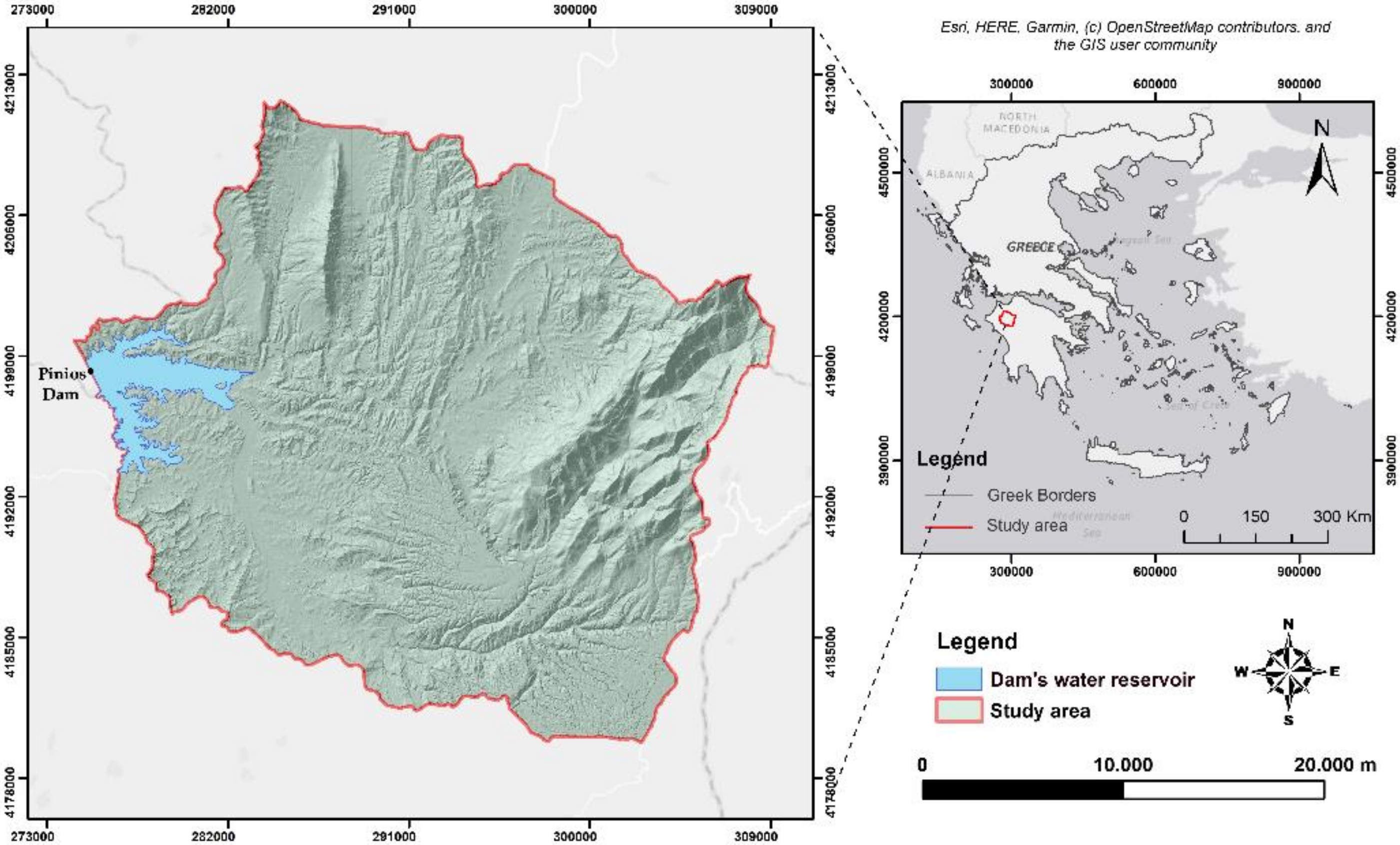
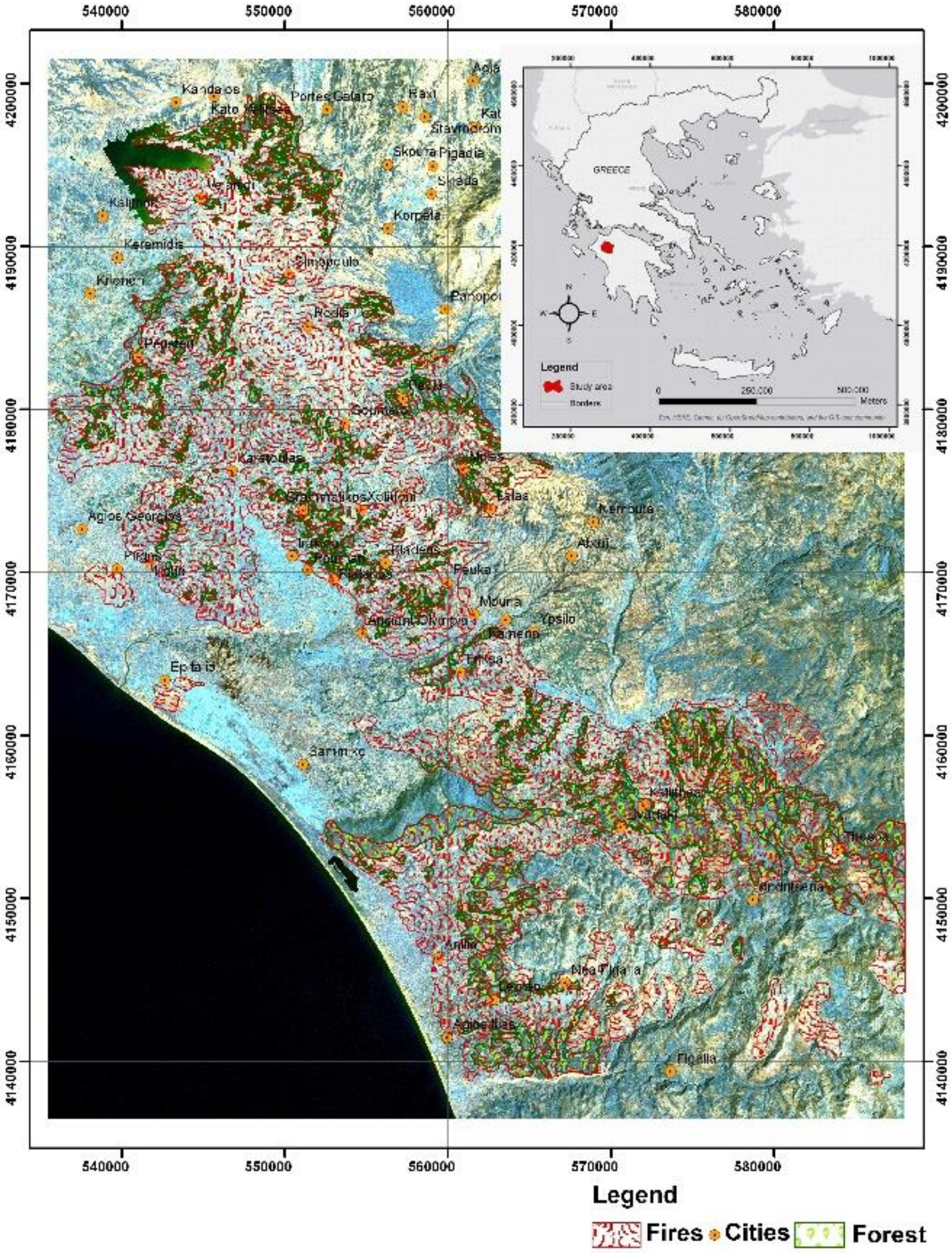
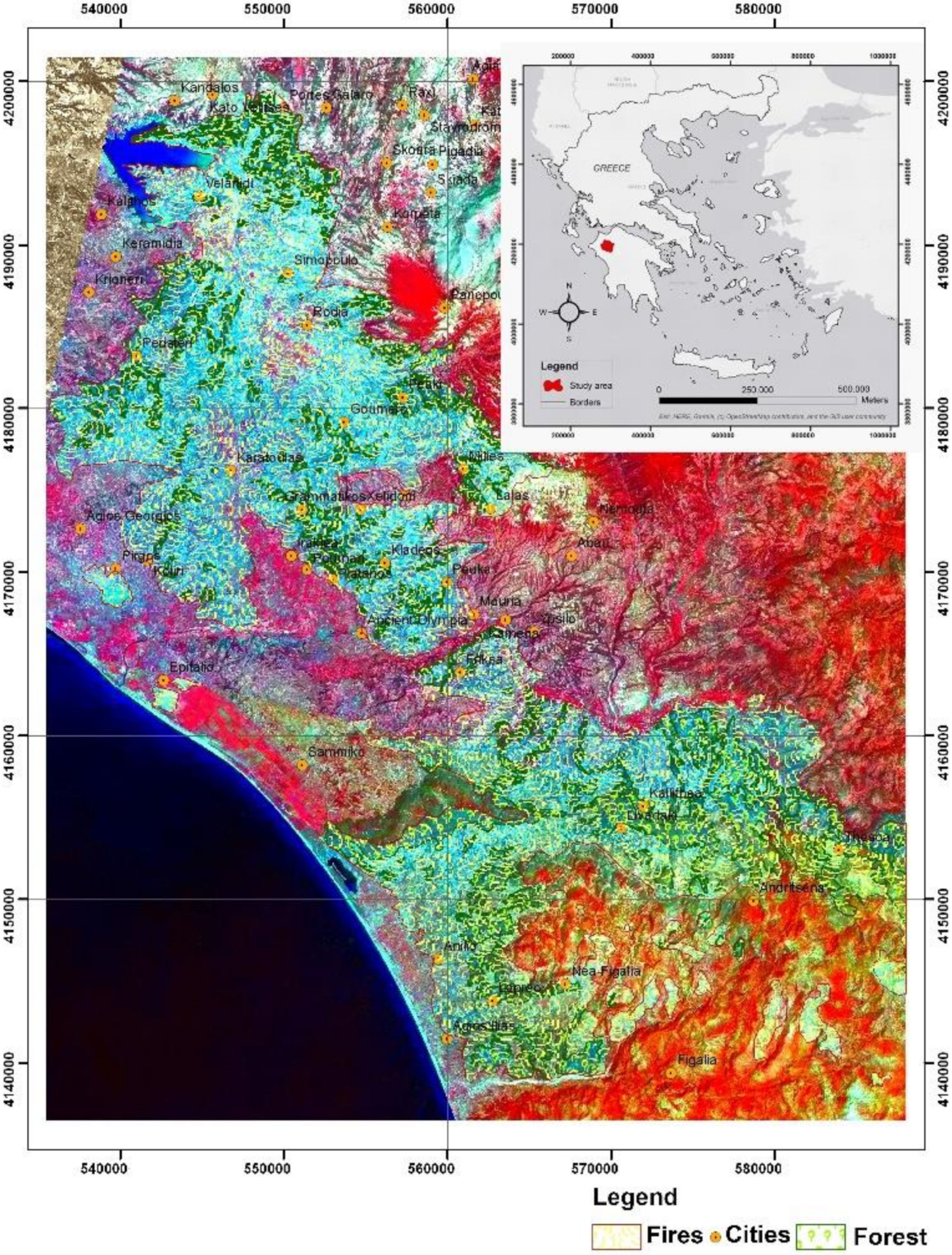



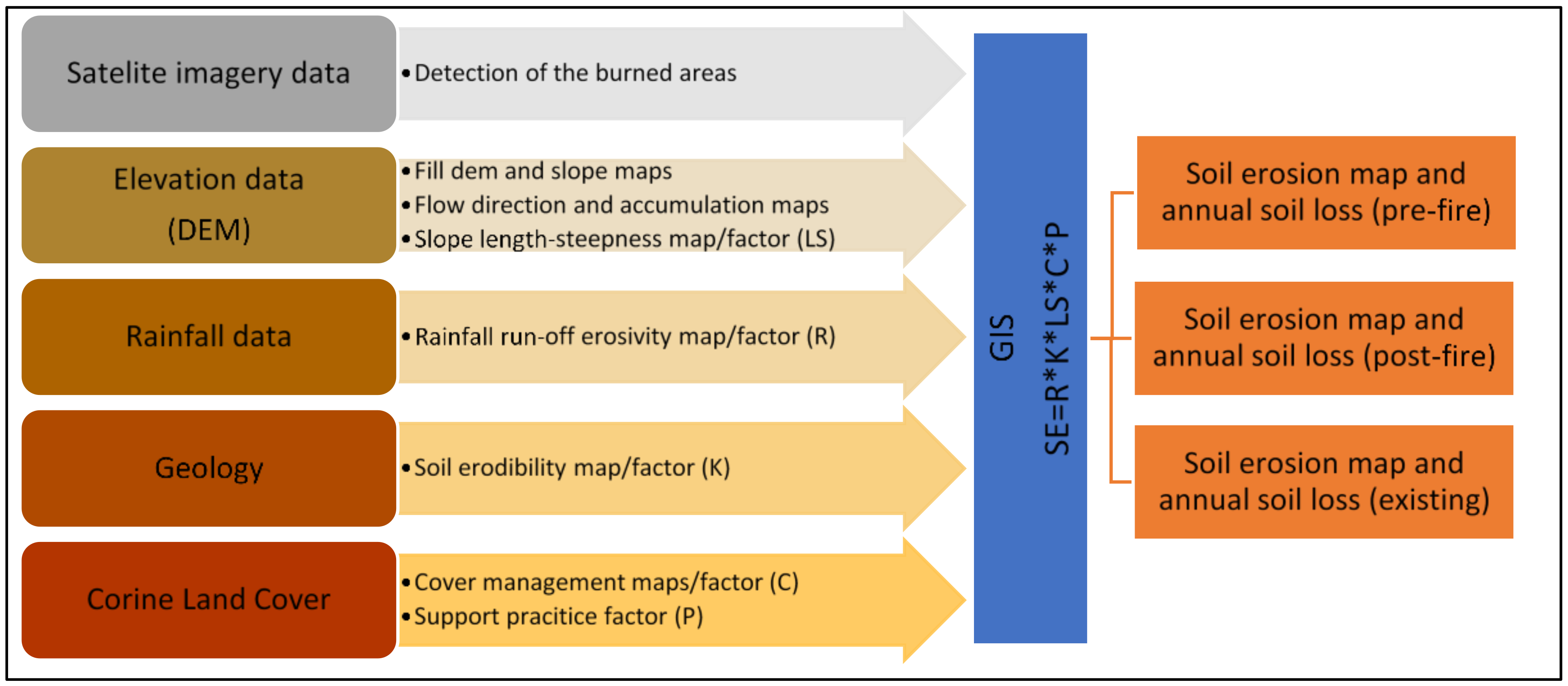
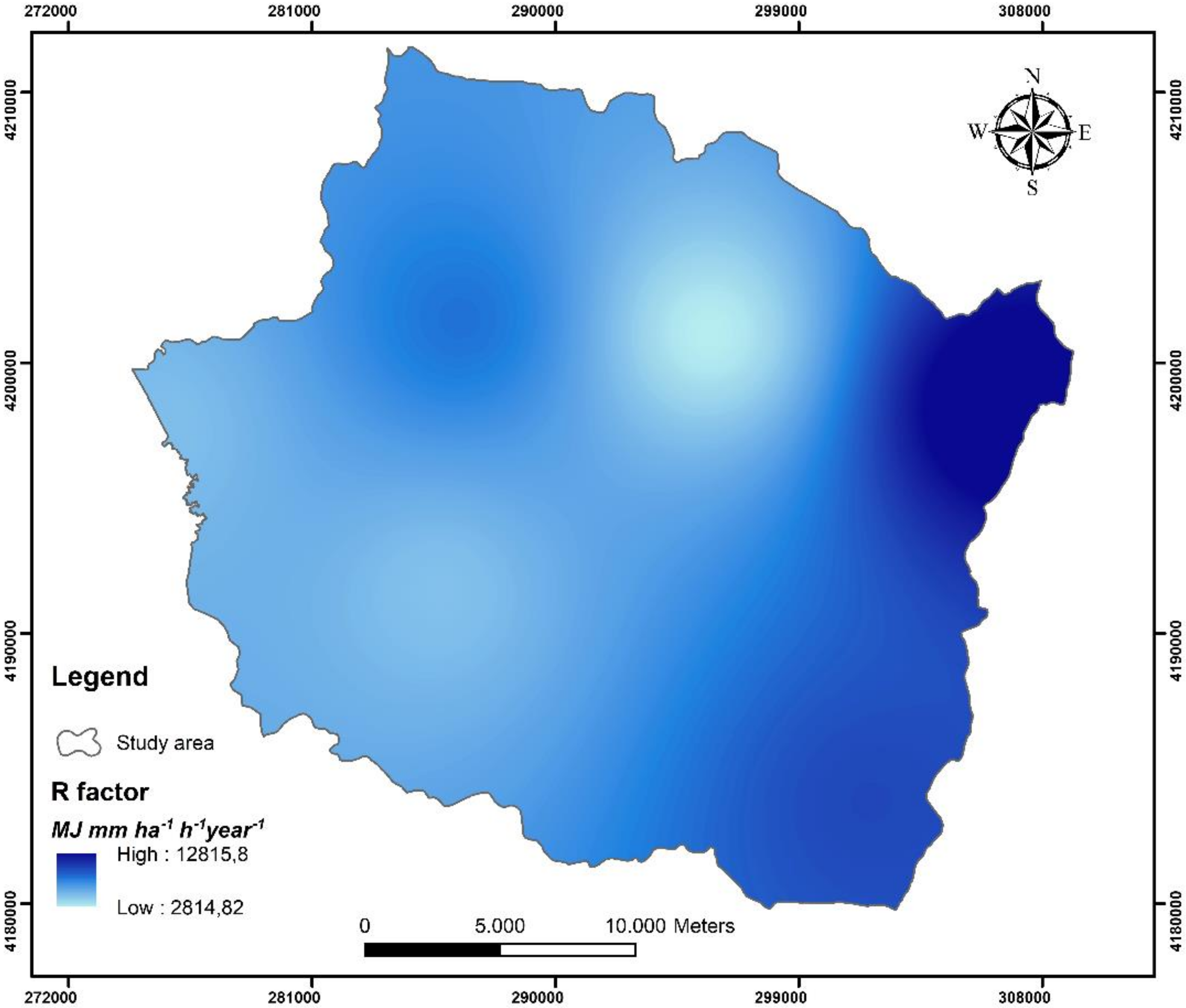
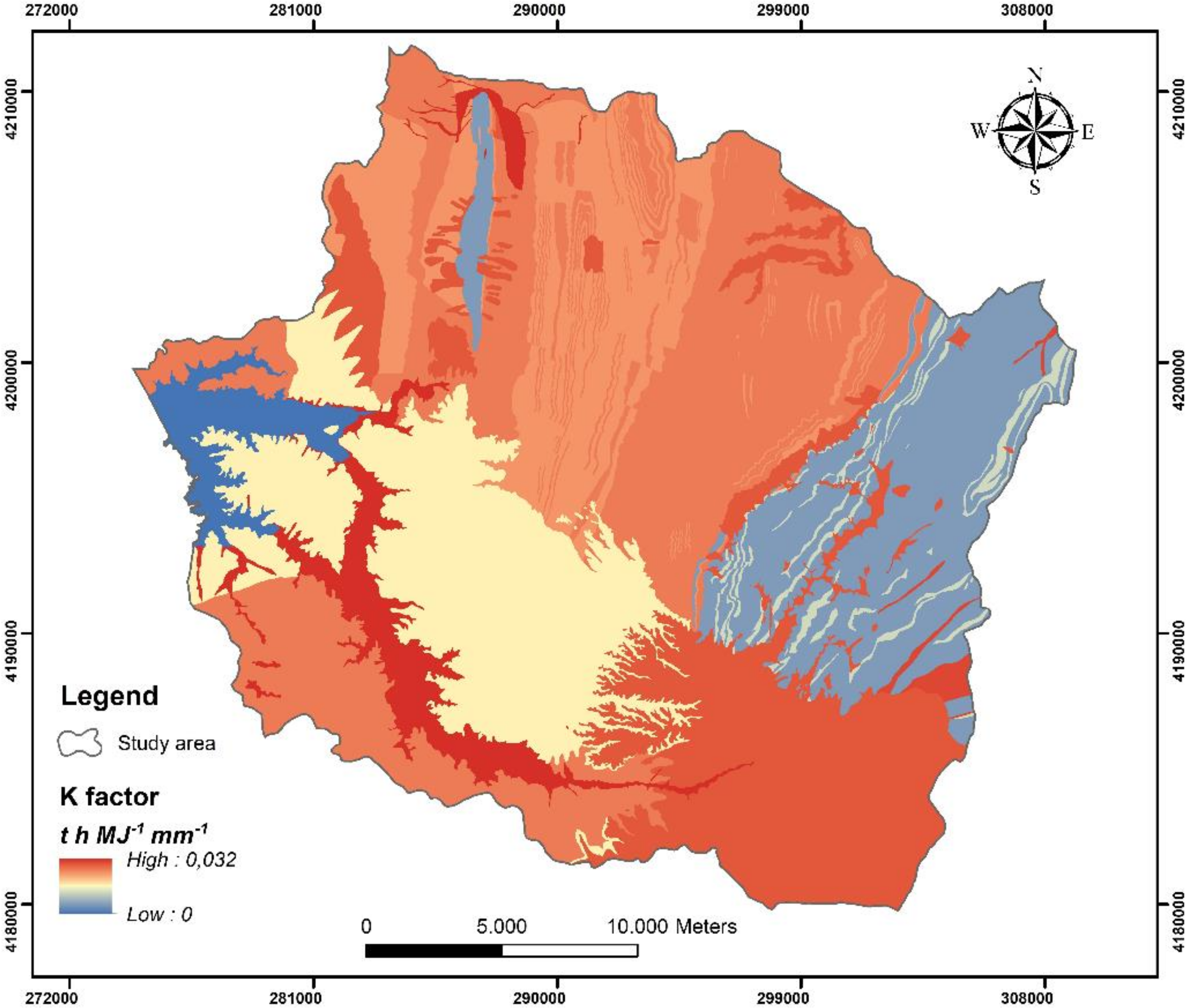
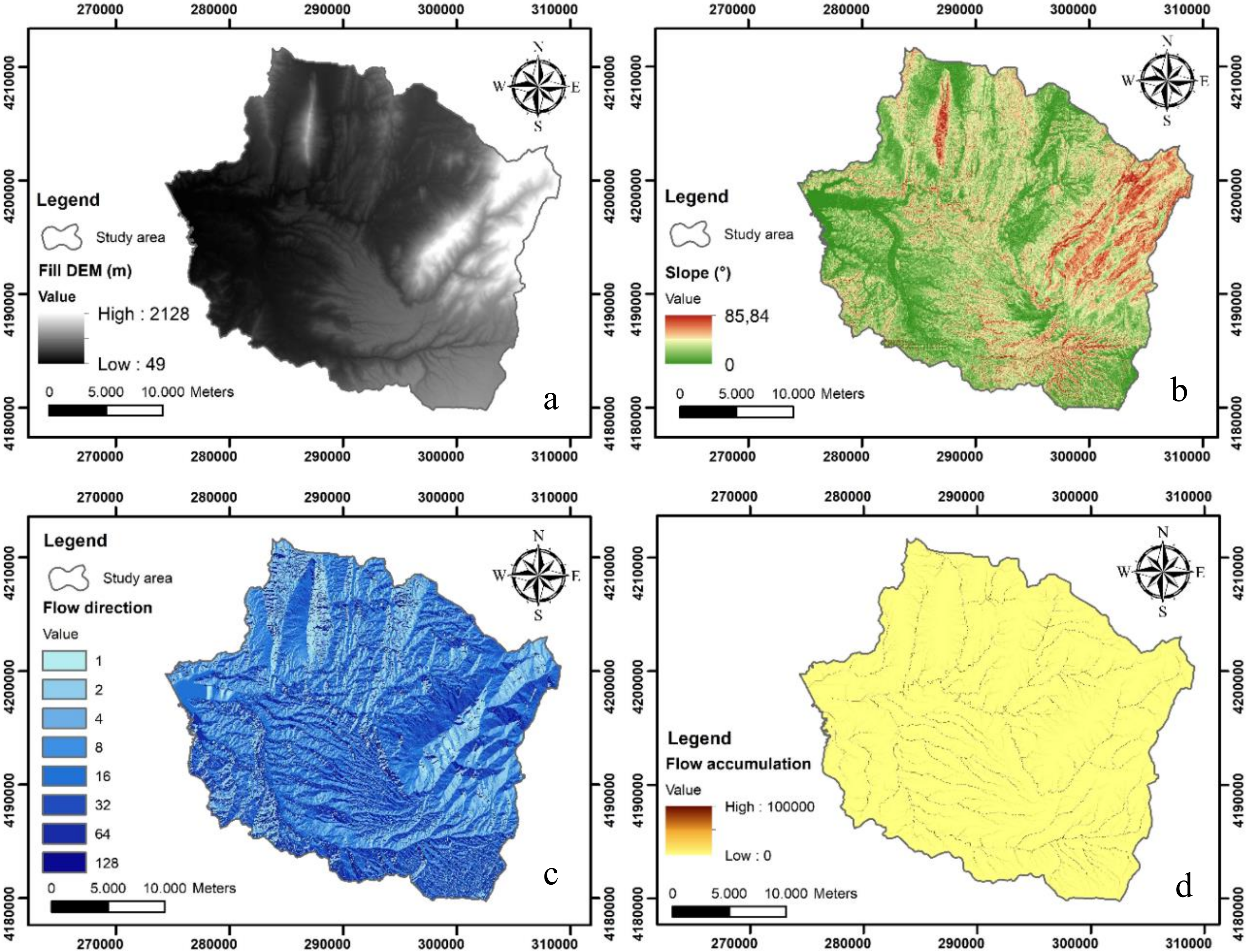
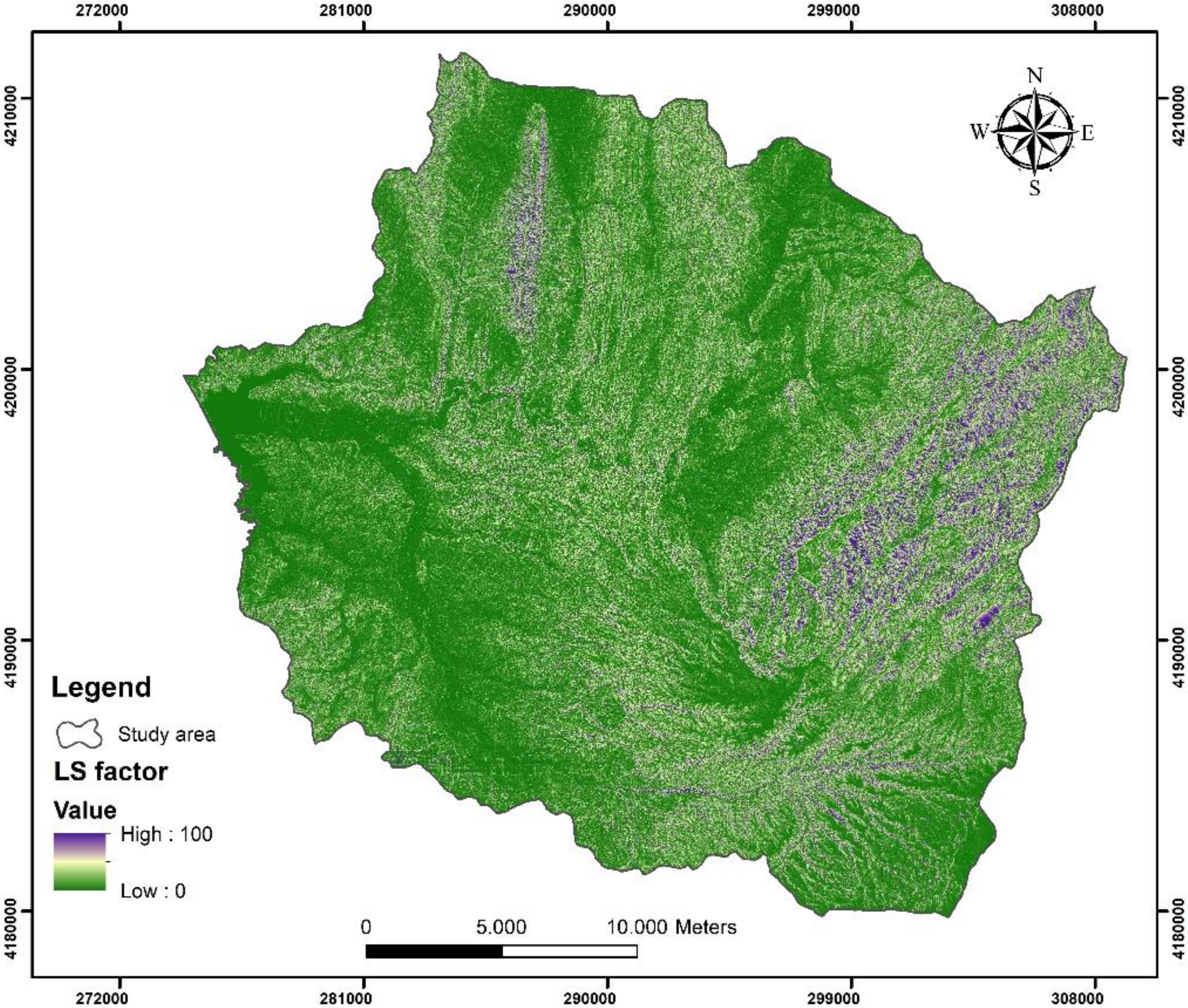
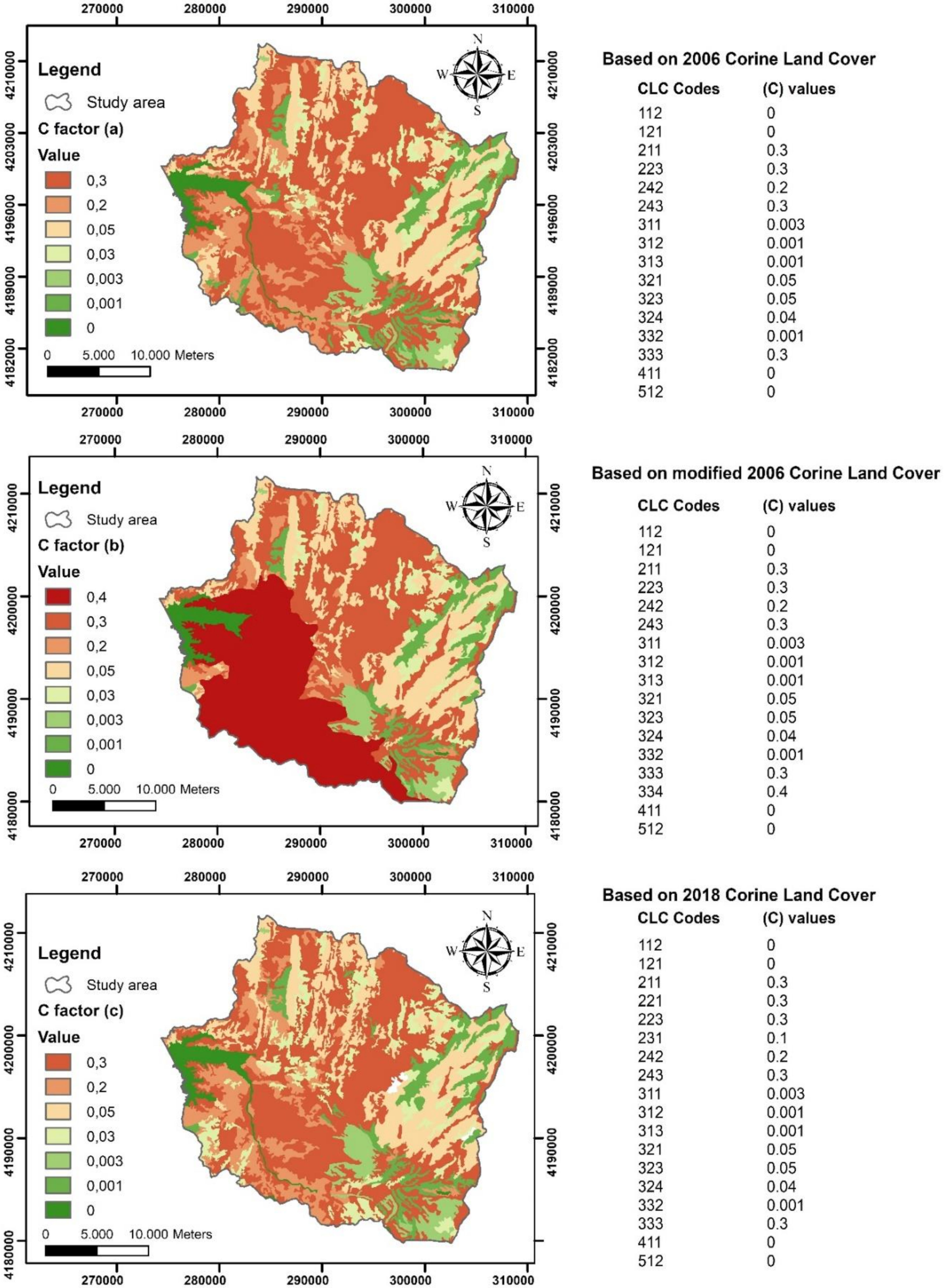
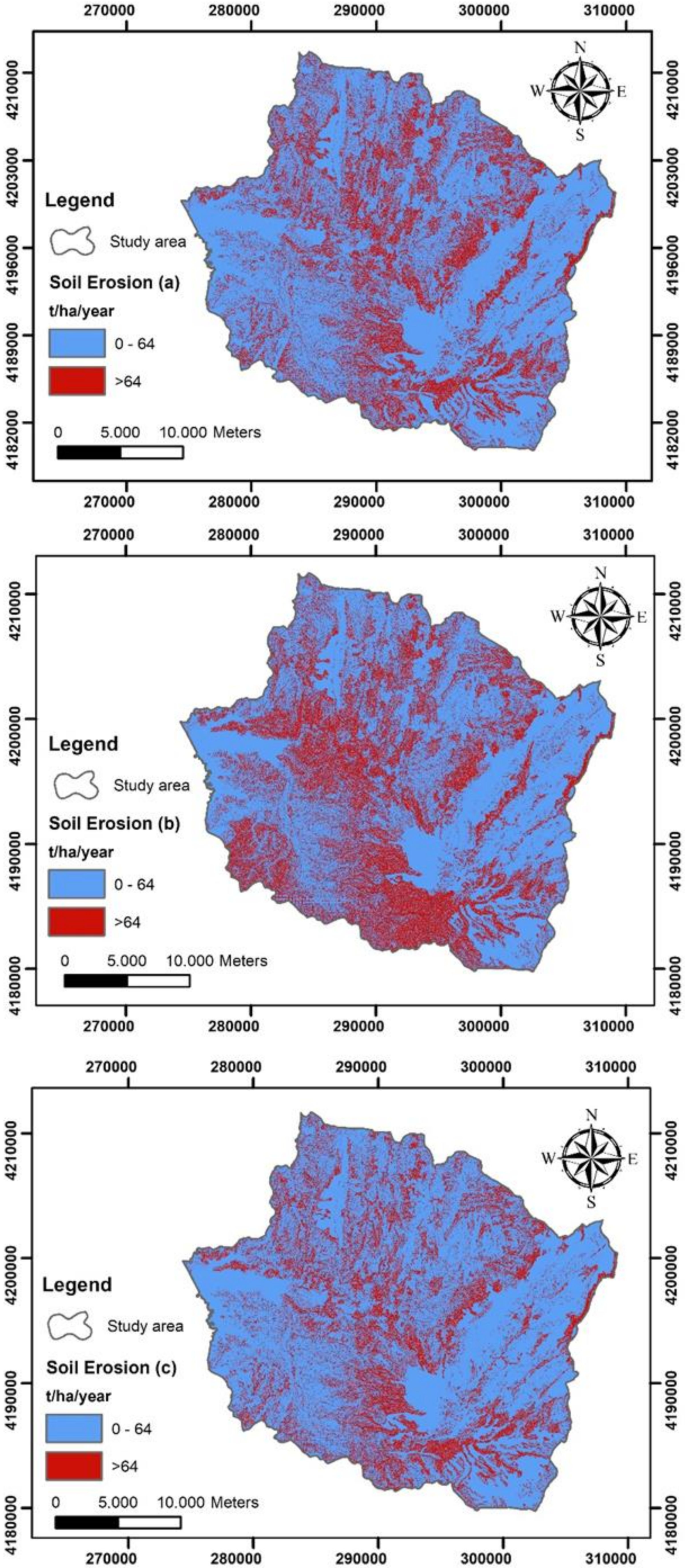
| Meteorological Stations | Elevation (m) | Coordinates (X, Y) (HGRS87 Datum *) | Modified Fournier’s Index (mm) | Precipitation (mm) | R Factor (MJ mm ha−1 h−1) | |
|---|---|---|---|---|---|---|
| Koumani | 500 | 301,656 | 4,183,754 | 144.9 | 1212 | 9227 |
| Kriovrisi | 950 | 306,409 | 4,198,446 | 169.8 | 1482.9 | 12,816 |
| Simopoulo | 211 | 285,702 | 4,191,557 | 102.5 | 847.3 | 4485 |
| Ksirohori | 291 | 295,710 | 4,201,094 | 82.1 | 722.9 | 2815 |
| Portes | 300 | 286,485 | 4,201,604 | 132.6 | 660.2 | 7676 |
| Pinios Dam | 82 | 275,361 | 4,197,535 | 103.8 | 783.8 | 4600 |
| Gastouni | 5 | 257,834 | 4,192,331 | 107.4 | 801.3 | 4947 |
| Geological Formations | K (t.h/MJ mm) |
|---|---|
| Quaternary deposits | 0.032 |
| Pleistocene coarse deposits | 0.029 |
| Plio–Pleistocene coarse deposits | 0.027 |
| Plio–Pleistocene fine deposits | 0.018 |
| Flysch with sandstones | 0.024 |
| Flysch with siltstones | 0.027 |
| Flysch basement | 0.031 |
| Transition zone (cherts, sandstones and siltstones) | 0.012 |
| Limestones | 0.005 |
© 2020 by the authors. Licensee MDPI, Basel, Switzerland. This article is an open access article distributed under the terms and conditions of the Creative Commons Attribution (CC BY) license (http://creativecommons.org/licenses/by/4.0/).
Share and Cite
Depountis, N.; Michalopoulou, M.; Kavoura, K.; Nikolakopoulos, K.; Sabatakakis, N. Estimating Soil Erosion Rate Changes in Areas Affected by Wildfires. ISPRS Int. J. Geo-Inf. 2020, 9, 562. https://doi.org/10.3390/ijgi9100562
Depountis N, Michalopoulou M, Kavoura K, Nikolakopoulos K, Sabatakakis N. Estimating Soil Erosion Rate Changes in Areas Affected by Wildfires. ISPRS International Journal of Geo-Information. 2020; 9(10):562. https://doi.org/10.3390/ijgi9100562
Chicago/Turabian StyleDepountis, Nikolaos, Maria Michalopoulou, Katerina Kavoura, Konstantinos Nikolakopoulos, and Nikolaos Sabatakakis. 2020. "Estimating Soil Erosion Rate Changes in Areas Affected by Wildfires" ISPRS International Journal of Geo-Information 9, no. 10: 562. https://doi.org/10.3390/ijgi9100562








